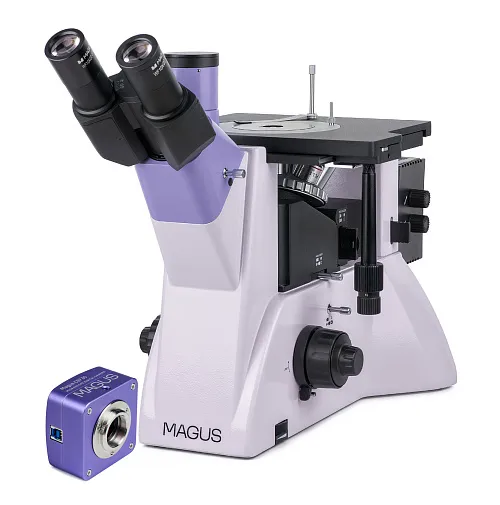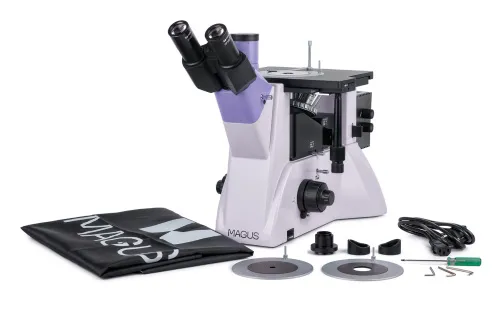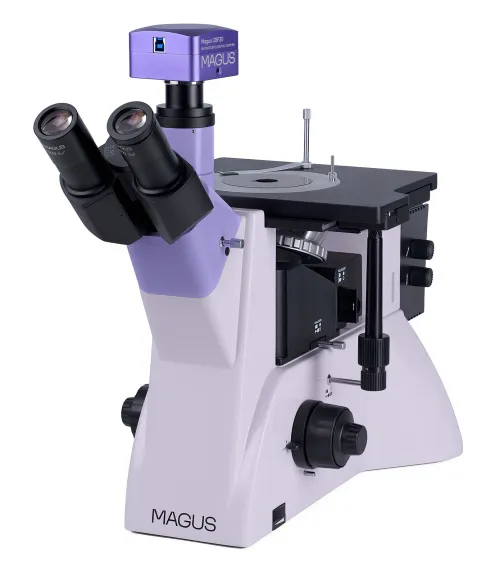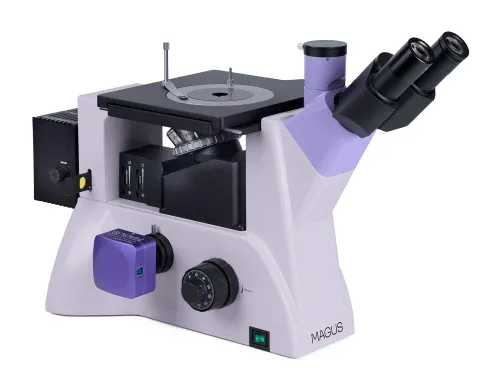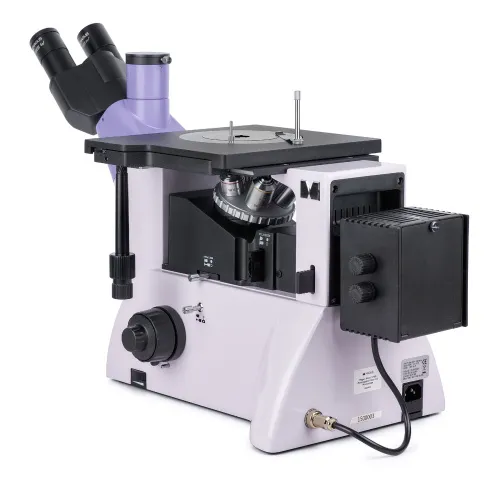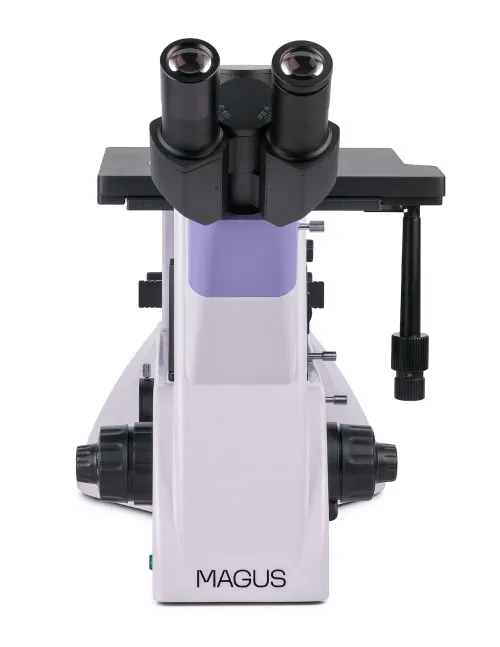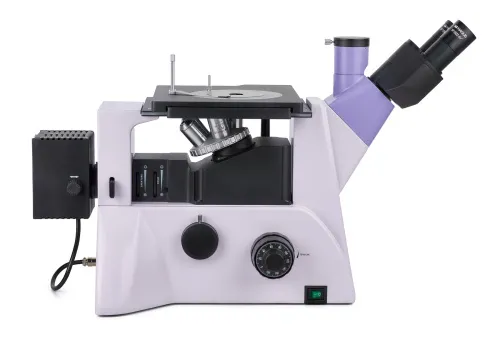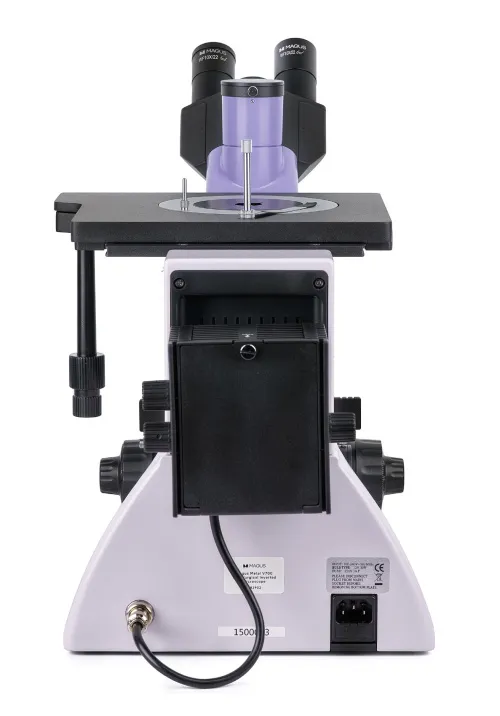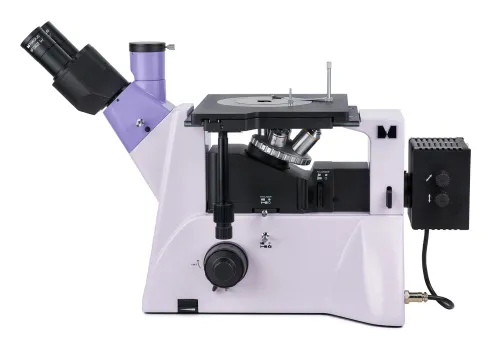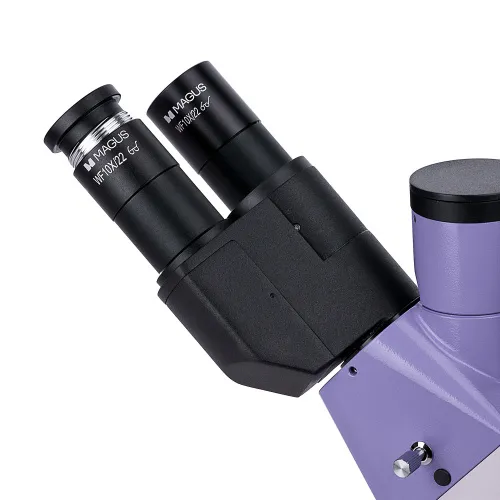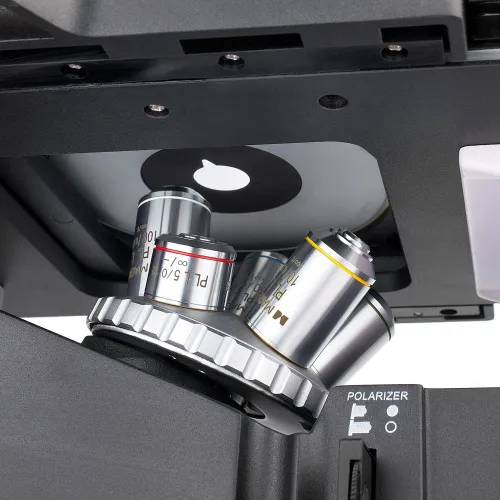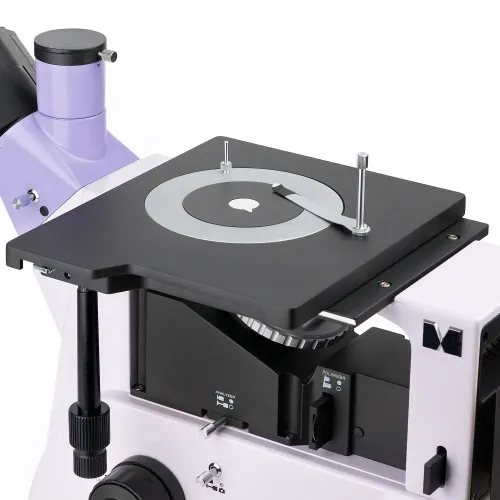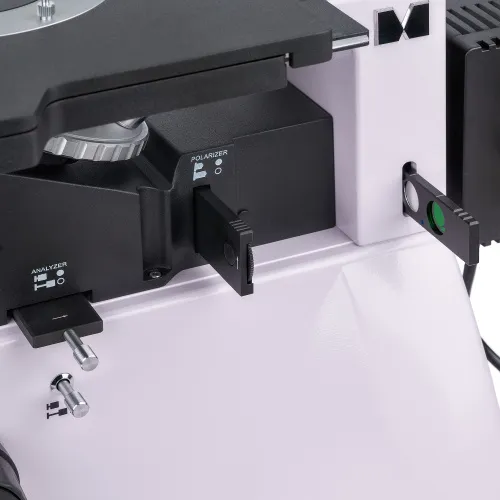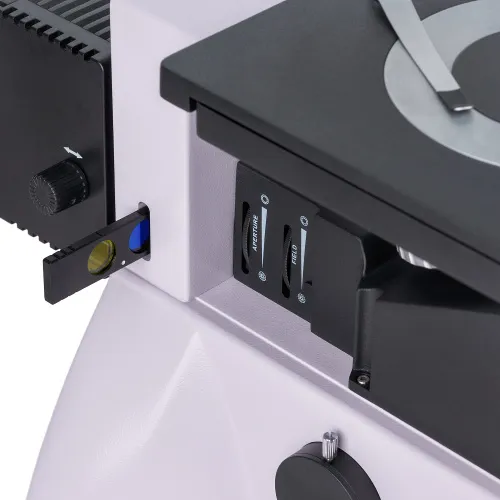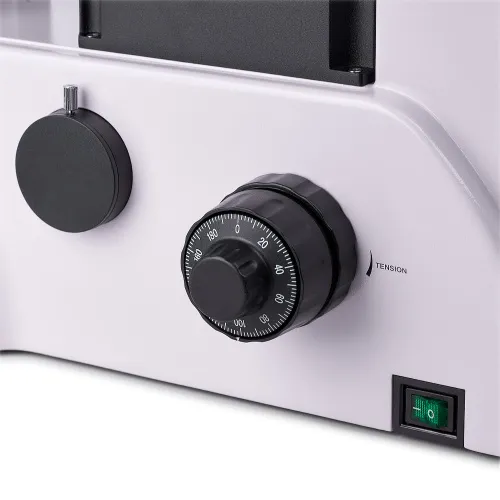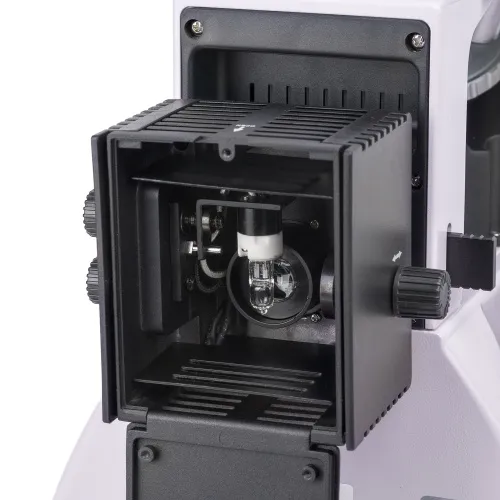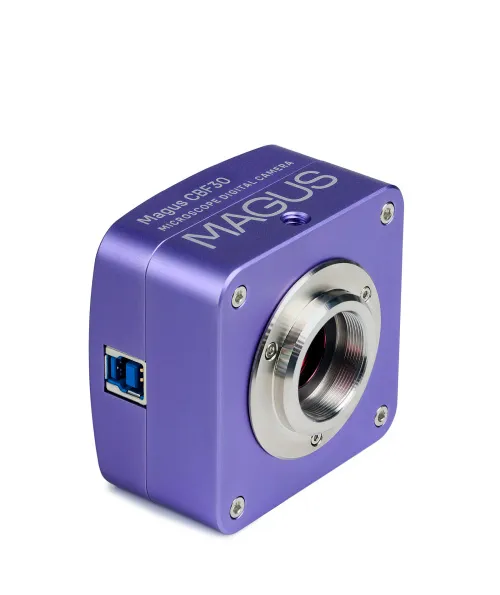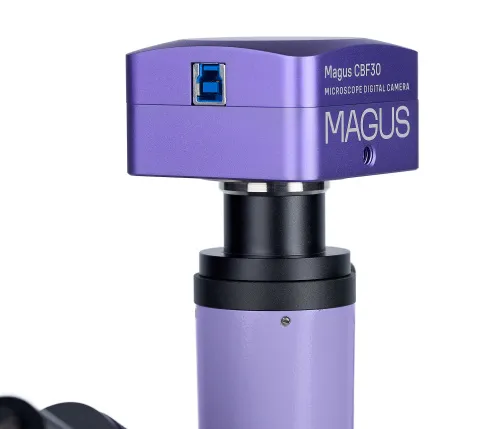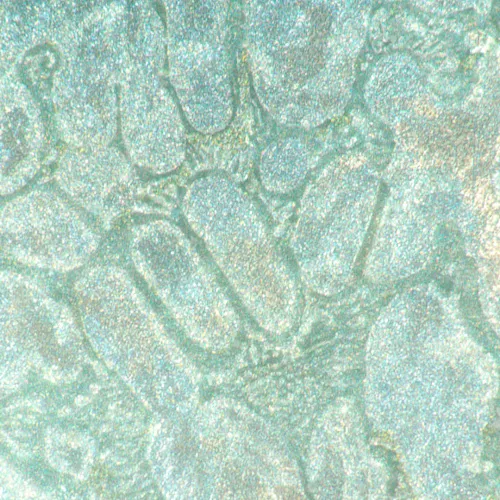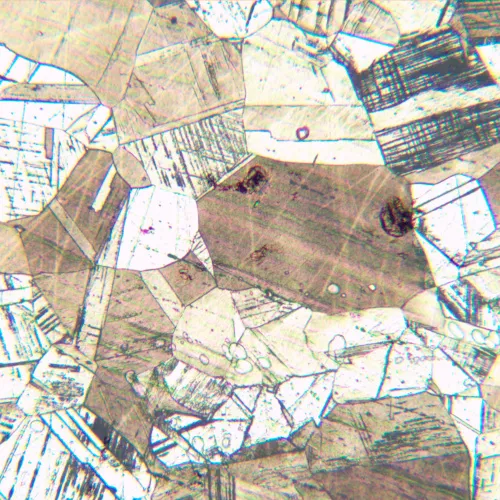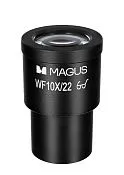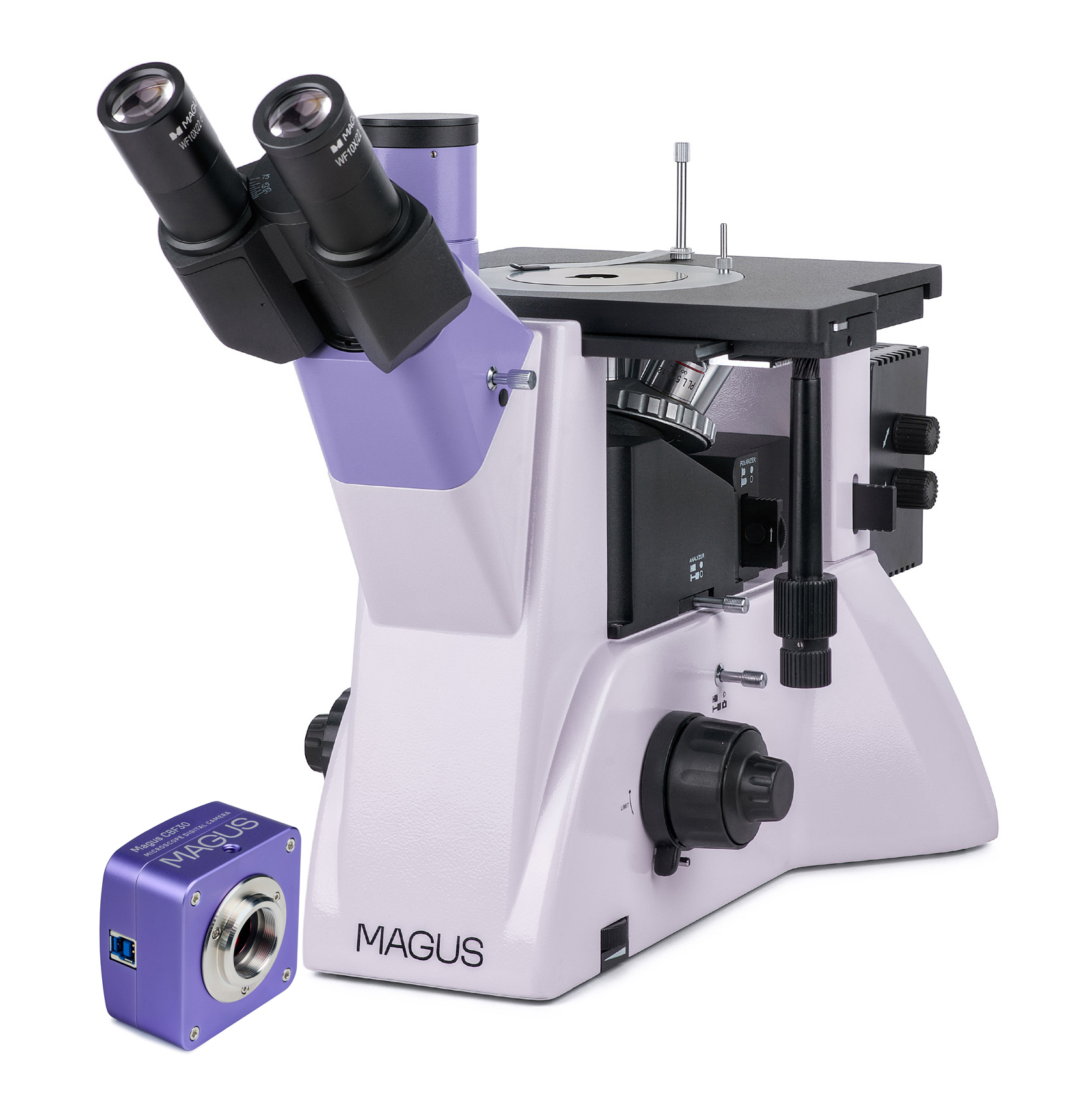MAGUS Metal VD700 Metallurgical Inverted Digital Microscope
With a camera. Magnification: 50–1000х. Trinocular head, infinity plan achromatic objectives, 30W halogen reflected light illuminator
| Product ID | 83036 |
| Brand | MAGUS |
| Warranty | 5 years |
| EAN | 5905555018454 |
| Package size (LxWxH) | 49x34x68 cm |
| Shipping Weight | 17.1 kg |
The MAGUS Metal VD700 Metallurgical Inverted Microscope is suitable for studying the microstructure of metals, alloys, and semiconductors in reflected light. The stage can hold samples up to 2kg (only the bottom surface of the sample must be flat). The other parts of the sample do not require processing and can be of any shape. The microscope is designed for brightfield and polarized light observations, has a side camera port and a trinocular tube, and it is suitable for a wide range of laboratory and production applications.
Digital camera
The MAGUS CBF30 Digital Camera enables you to take photographs and shoot video through a microscope, edit the resulting files, organize presentations, and make linear and angular measurements of objects (after correct calibration).
The device is designed to work on microscopes using the brightfield method and 4x, 10x, 20x, and 40x objectives.
The 6.3MP sensor enables you to shoot bright and detailed photos and videos at a maximum resolution of 3072x2048px. If necessary, the resolution can be lowered to 1536x1024px. However, this will not affect the frame rate, which will remain at 59fps, thereby ensuring smooth frame transitions without jerkiness or delays.
The SONY Exmor backlit color CMOS sensor enables you to use the camera even in low-light conditions. The image will remain readable and bright. Using an adapter with a magnification from 0.5x to 0.75x will provide the clearest possible image without distortion.
Optics
The microscope is equipped with a trinocular head of special design – the position of the eyepieces can be adjusted; 180° rotation is available. The digital camera is mounted in the side camera port on the microscope body and the monitor is mounted in the trinocular tube on the microscope head. Beam splitting on the body – 100:0/0:100, on the trinocular head is 50:50 and 100:0.
The revolving nosepiece is located under the examined sample and has 5 objective slots (all of them are included in the basic configuration). All objectives are infinity plan achromatic ones with long working distances. An additional objective can be mounted instead of any of the supplied objectives. In the basic configuration, the microscope magnification ranges from 50x to 1000x.
Illumination
The reflected light illuminator has a 30W halogen bulb with adjustable brightness. The lamphouse is powered by an AC power supply. It is bright enough for making observations with all the included objectives using brightfield or polarization microscopy techniques. There is an option to set up the Köhler illumination, and the light source can be centered along three axes. Color filters can be used to change color rendition in microscopic photography. There are polarization devices – an analyzer and a polarizer – that are both removable.
Stage and focusing mechanism
A round stage plate with a 10mm, 20mm, or 30mm hole that is inserted in the stage, and the specimen is fixed with a specimen holder. The stage is quite large (242x200mm) and it moves with the attached specimen along two axes. You can adjust the sharpness of the image using the coarse and fine focusing knobs. You can adjust the stiffness of the coarse knob tension, and there is a lock knob.
Accessories
Additional accessories make it possible to get the most out of the MAGUS Metal VD700 microscope. Eyepieces, long working distance plan achromatic objectives, calibration slides, and digital cameras are available.
Key features of the microscope:
- Study of large and heavy samples using brightfield and polarization microscopy techniques; only one side of the sample should be processed
- Large stage, round rotating stage plates with 10mm, 20mm, and 30mm holes
- The trinocular head can be rotated 180° during installation
- Two options for mounting a digital camera and monitor: on the trinocular head with 50:50 and 100:0 beam splitting or on the microscope body with 100/0 or 0/100 beam splitting
- Reflected light observations, light source – 30W halogen bulb with adjustable brightness
- Köhler illumination setup, removable analyzer and polarizer, and a light source that can be centered
- Large selection of compatible accessories to expand the capabilities of the microscope
Key features of the camera:
- Recommended for use with low magnification objectives
- Color light-sensitive sensor for clear images even in low light conditions
- Frame rate of 59fps, which is enough for the observation of moving objects or fast-moving processes
- The kit includes software that fully ensures the functionality of all the camera features and, consequently, a “quick start”
- Reliable USB3.0 interface for high data transfer speeds
- Resolution adjustment so that you can choose the option that suits you the best at any given moment
The kit includes:
- MAGUS CBF30 Digital Camera (digital camera, USB cable, installation CD with drivers and software, user manual and warranty card)
- Base with a power input, focusing mechanism, stage, and revolving nosepiece
- Reflected light illuminator with a lamphouse
- Trinocular head
- Infinity plan achromatic objective: PL L5x/0.12 WD 26.1mm
- Infinity plan achromatic objective: PL L10х/0.25 WD 20.2mm
- Infinity plan achromatic objective: PL L20х/0.40 WD 8.80mm
- Infinity plan achromatic objective: PL L50х/0.70 WD 3.68mm
- Infinity plan achromatic objective: PL L100x/0.85 (dry) WD 0.40mm
- Eyepiece 10x/22mm with long eye relief (2 pcs.)
- C-mount adapter 1x
- Hex key wrench
- AC power cord
- Dust cover
- User manual and warranty card
Available on request:
- 10x/22mm eyepiece with a scale
- 12.5x/14mm eyepiece (2 pcs.)
- 15x/15mm eyepiece (2 pcs.)
- 20x/12mm eyepiece (2 pcs.)
- 25x/9mm eyepiece (2 pcs.)
- Infinity plan achromatic objective: PL L40х/0.60 WD 3.98mm
- Infinity plan achromatic objective: PL L60x/0.70 WD 2.08mm
- Infinity plan achromatic objective: PL L80x/0.80 WD 1.25mm
- Calibration slide
| Product ID | 83036 |
| Brand | MAGUS |
| Warranty | 5 years |
| EAN | 5905555018454 |
| Package size (LxWxH) | 49x34x68 cm |
| Shipping Weight | 17.1 kg |
| Microscope specifications | |
| Type | light/optical, digital, metallurgical |
| Microscope head type | trinocular |
| Head | Siedentopf, rotatable 180° |
| Head inclination angle | 45 ° |
| Magnification, x | 50 — 1000 |
| Magnification, x (optional) | 50–1250/1500/2000/2500 |
| Eyepiece tube diameter, mm | 30 |
| Eyepieces | 10х/22mm, eye relief: 10mm (*optional: 10x/22mm with scale, 12.5x/14; 15x/15; 20x/12; 25x/9) |
| Objectives | infinity plan achromatic: PL L5x/0.12, PL L10x/0.25, PL L20x/0.40, PL L50x/0.70, PL L100x/0.85 (dry); parfocal distance 45mm (*option: PL L40x/0.60, PL L60x/0.70, PL L80x/0.80) |
| Revolving nosepiece | for 5 objectives |
| Working distance, mm | 26.1 (5x); 20.2 (10x); 3.98 (40x); 2.08 (60x); 8.80 (20x); 3.68 (50x); 1.25 (80x); 0.40 (100x) |
| Interpupillary distance, mm | 48 — 75 |
| Stage, mm | 242x200 |
| Stage moving range, mm | 30/30 |
| Stage features | round rotating stage plate Ø130mm with holes Ø10mm, Ø20mm and Ø30mm, two-axis mechanical |
| Diaphragm | built-in aperture and field |
| Focus | coaxial, coarse (with coarse focusing tension adjustment and a lock knob), and fine (0.002mm) |
| Illumination | halogen |
| Brightness adjustment | ✓ |
| Power supply | 220±22V, 50Hz, AC network |
| Light source type | 12V/30W |
| Light filters | green, blue, yellow, matt |
| Operating temperature range, °C | 5...+35 |
| Additional | removable analyzer and polarizer |
| User level | experienced users, professionals |
| Assembly and installation difficulty level | complicated |
| Application | metallurgical |
| Illumination location | lower (reflected light) |
| Research method | bright field, polarization |
| Pouch/case/bag in set | dust cover |
| Camera specifications | |
| Sensor | SONY Exmor CMOS |
| Color/monochrome | color |
| Megapixels | 6.3 |
| Maximum resolution, pix | 3072x2048 |
| Sensor size | 1/1.8" (7.37x4.92mm) |
| Pixel size, μm | 2.4x2.4 |
| Light sensitivity | 425mV at 1/30s |
| Signal/noise ratio | 0.15mV at 1/30s |
| Exposure time | 0.02ms–15s |
| Video recording | ✓ |
| Video recording | yes |
| Frame rate, fps at resolution | 59@1536x1024, 59@3072x2048 |
| Place of installation | trinocular tube, eyepiece tube instead of an eyepiece |
| Image format | *.jpg, *.bmp, *.png, *.tif |
| Video format | output: *.wmv, *.avi, *.h264 (Windows 8 and later), *h265 (Windows 10 and later) |
| Spectral range, nm | 380–650 (built-in IR filter) |
| Shutter type | ERS (electronic rolling shutter) |
| White balance | automatic, manual |
| Exposure control | automatic, manual |
| Software features | brightness, exposure time, image size |
| Software | MAGUS View |
| Output | 5Gb/s, USB 3.0 |
| System requirements | Windows 8/10/11 (32bit and 64bit), Mac OS X, Linux, up to 2.8GHz Intel Core 2 or higher, minimum 2GB RAM, USB 3.0 port, CD-ROM, 17" or larger display |
| Mount type | C-mount |
| Body | solid aluminum |
| Camera power supply | DC, 5V, from computer USB port; a 12V, 3A adapter for Peltier element |
| Camera operating temperature range, °С | -10...+50 |
| Operating humidity range, % | 30 — 80 |
and downloads
We have gathered answers to the most frequently asked questions to help you sort things out
Find out why studying eyes under a microscope is entertaining; how insects’ and arachnids’ eyes differ and what the best way is to observe such an interesting specimen
Read this review to learn how to observe human hair, what different hair looks like under a microscope and what magnification is required for observations
Learn what a numerical aperture is and how to choose a suitable objective lens for your microscope here
Learn what a spider looks like under microscope, when the best time is to take photos of it, how to study it properly at magnification and more interesting facts about observing insects and arachnids
This review for beginner explorers of the micro world introduces you to the optical, illuminating and mechanical parts of a microscope and their functions
Short article about Paramecium caudatum - a microorganism that is interesting to observe through any microscope

